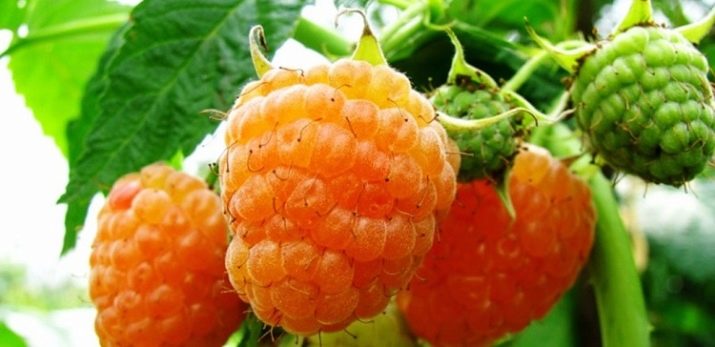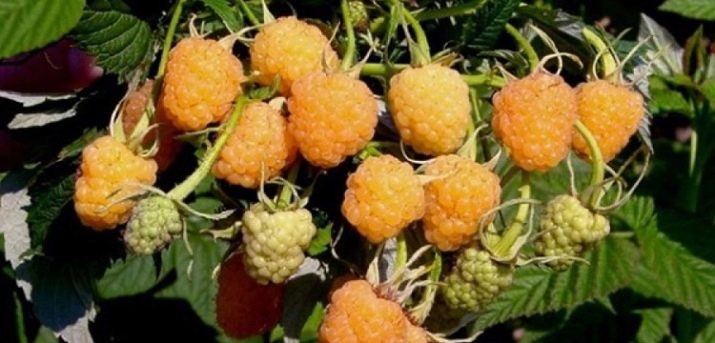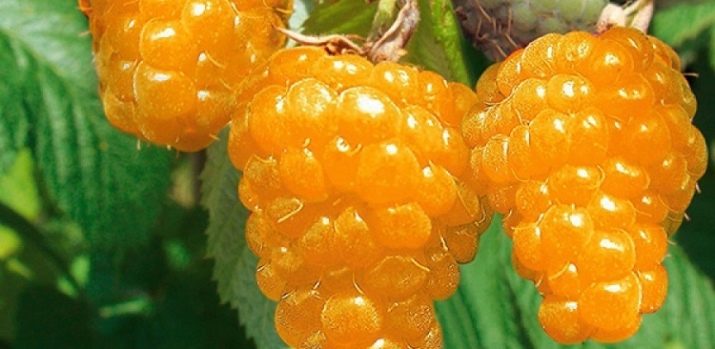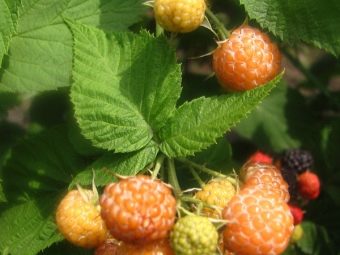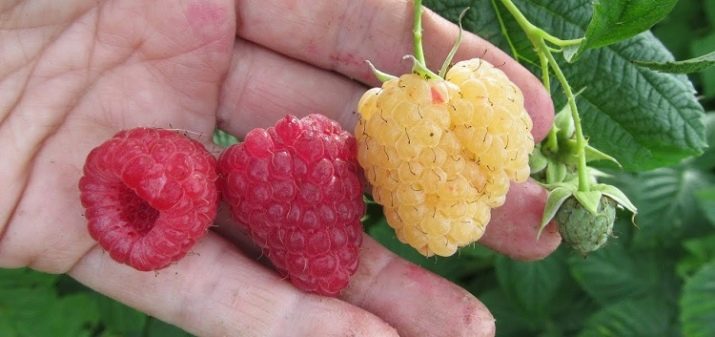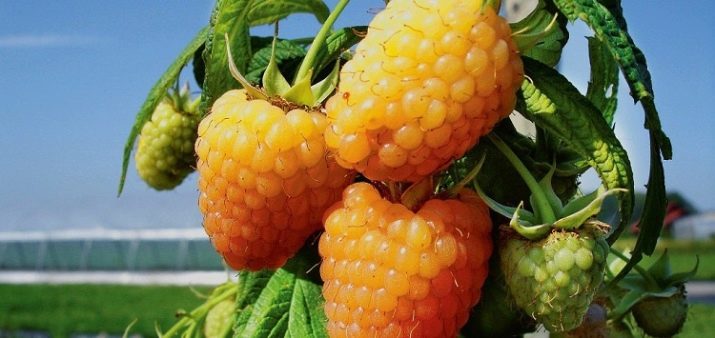Yellow raspberry: varieties and characteristics of growing
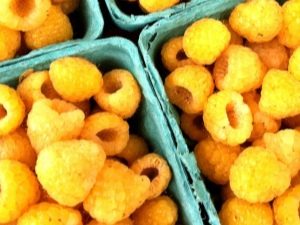
Among gardeners there is a perception that one of the most interesting and unusual berries is yellow raspberry. You will rarely meet this garden crop on your household plots, because its sister is most often grown - red raspberries. However, the unusual color of this berry attracts an increasing number of summer residents.
What is this berry?
Yellow raspberry as a variety was bred for a long time. However, over time, the red raspberry almost completely took its place. One of the reasons for “oblivion” can be called the not so bright aroma of yellow berries and a shorter period of further storage. Perhaps the reason for the low popularity of this culture was the banal ignorance of gardeners about it.
Yellow raspberry is a perennial shrub. The root system of the plant is perennial, while the stems usually live one to two years. As with any other raspberry variety, yellow fruit is characterized by a two-year period of growth and development. In the first year, new shoots germinate, and only by the second year they become overgrown with fruits. In the third year, the shoots die off, so it is necessary to thin out the raspberries by removing old stalks.
Raspberries are usually divided into ordinary and remontant. The usual ripens in the midst of summer: June - July, and the remontant ripens twice a year.
It is necessary to consider in more detail the concept of remontant raspberry. The repair is called raspberry, which bears fruit on the shoots of the current year. Late autumn raspberry is pruned almost at the root. In the spring, new shoots appear, which begin to bear fruit by the end of summer.
Some plant varieties can withstand low temperatures, while others, on the contrary, do not tolerate cold. In winter, experts advise to bend the shoots to the ground and cover them with snow.
The fruits of this plant are dessert. The aroma of yellow raspberry is not as pronounced as that of red, but the taste is no different - just as bright and honey-sweet.
Yellow raspberry belongs to the genus "Rubus" family "Pink". Raspberry rhizome strong, very winding, lives for several years. Adventitious roots grow on the rhizome, therefore the root system of the plant is strong and branched.
Stems of plants are straight, grow on average up to 2.5 meters. For the first year, the shoots have a soft peel, grassy in appearance. On the shoot there are many small thin needles. The following year, the shoots become harder, "lumber", the color becomes brown. After harvesting the shoots dry up. By the next year the young shoots are formed again. Leaves oval plants, inflorescences in the form of a brush.
The period of flowering of yellow raspberry depends on the climate of the region where it grows. The shrub usually begins to bloom at the beginning of summer, and flowering ends in late July. The aroma of flowers is pleasant, slightly sweet. The fruits of the shrub are large, regular oval. The weight of one berry is from 4 to 6 grams.
One of the most popular varieties is the Orange Miracle. According to the statement of breeders, the variety is unassuming - it grows on almost any soil, is unpretentious to the weather. The plant is resistant to various types of diseases and pests.
Consider the difference between the red and yellow-fruited raspberries. The difference is really not that big. The yellow pigment of the berry is caused by the low content of anthocyanins in it. Anthocyanin is a coloring matter. Due to this property, yellow berries do not cause allergies, so they can be eaten by young children, pregnant women and people who suffer from allergies.
Advantages and disadvantages
Yellow raspberry has many advantages. First of all, this is the absence of an allergic reaction to the berry. The fruits contain a sufficient amount of folic acid and various vitamins (for example, vitamins of group B).
This variety is characterized by good yield, resistance to various diseases and a rather long period of fruiting. Ripening berries occurs gradually. According to reviews of gardeners with proper care for the plant with one bush, you can get up to 6 kilograms of berries per season.
The fragrant fruits of yellow raspberries are dessert. The taste of berries is rich, sweet.
For allergy sufferers, yellow raspberries will be just salvation. Due to the small composition of anthocyanins in its composition berries are dietary. Therefore, those who can not eat red raspberries, can eat yellow without fear of the onset of an allergic reaction.
Of course, this plant is not without some drawbacks. The berries are too soft, their density is not very high, therefore the fruits are unsuitable for transportation, unlike red raspberries.
On the stems of the bush there are small thorny thorns. This repels many gardeners, as the process of picking berries becomes difficult and often painful. After all, being fascinated by the assembly of berries, one can easily overlook the little prickly spikes.
The plant has a developed, powerful and fast-growing root system. This fact is important to remember, because if you do not remove the extra root processes in time, the shrub will quickly grow and flood the surrounding space. Growing unnecessary raspberry bushes in the future will be very difficult to root out.
Old varieties of berries were perishable, completely unsuitable for storage. The structure of the berries were watery, almost immediately fell from the bush.
But science does not stand still. Breeders bring all new varieties of shrubs that do not have these disadvantages. New varieties (Amber, Golden Autumn) withstand transportation and are suitable for longer storage.
It is worth noting that growing yellow fruit raspberries is a profitable business. The shrub will begin to bear fruit in the second year after it has been planted, and in warm climates you will be able to enjoy the berries in the first year after planting.
Sorta
The abundance of varieties of yellow raspberry enthralls not only professional gardeners, but also ordinary recreational amateurs. For many years, agronomists and breeders developed the best yellow-fruit shrubs. This includes the early summer varieties of the garden yellow-fruit raspberry, which has ripened already in mid-July, and later remontant species bearing fruit throughout September.
Let us consider in more detail the description of each of the popular varieties of yellow raspberry.
Orange Miracle
It is called the variety of the future. The characteristics of this variety make it the elite among the yellow raspberry bushes. Here are some of them:
- this species takes root on almost any soil;
- unpretentious to weather conditions;
- has resistance to diseases and pests;
- ripened berries for a long time do not fall from the bush;
- ripen in the second half of August and ripen until late autumn, until the first snow.
Raspberry is a large-fruited. The mass of one berry reaches 6 grams. Their taste is delicate, aromatic and sweet.
But the most valuable quality of this variety is the possibility of its transportation. Such a property as berry transportability helps grow raspberry fruit for sale.
Yellow Giant
This variety is also popular in horticultural crops. It belongs to the remontant varieties. But here lies a small catch. In colder regions, such raspberries will behave like a normal variety, rather than a remontant one.
And in the southern regions of the variety can be attributed to the remontant. In the first year, the raspberries will bloom around mid-July, and the berries will appear in late summer - early autumn. In the future, the upper part of the stem is cut, so that in the subsequent year the lower part of the shoot will blossom. In the autumn after harvest, the rest of the stem is cut closer to the root. The variety is winter hardy.
The height of the raspberry bush is more than 2 meters. The stems of the plant are strong, powerful. Up to 25 berries grow on each shoot. The weight of each fruit is from 7 to 10 grams.
The berries have the shape of a slightly elongated oval, covered with a small down, apricot or pale yellow. Berry seeds are small, white. The taste of the berries is pleasant, slightly sour.
Up to 7 kilograms of berries can be harvested from one bush per season with proper care of the plant.
"The Runaway"
Can be grown in northern areas. It is remontant raspberries, tolerates winter. Fruiting begins in July.
Fruit weight on average from 3 to 6 grams. It has a rounded shape and a paler color than the "Yellow Giant". It tastes sourish. Raspberry stalks are powerful, reaching a height of two meters. During the season about 2-3 kilograms of berries can be removed from the bush.
The disadvantages of the variety include low transportability and poor tolerance to drought and high temperature.
"Apricot"
The variety of yellow raspberry got its name because of the similarity of berries with apricots - in color and taste. Yellowish fruits taste sour. Berry weight from 3 to 4 grams. During the season, summer residents remove from one shrub up to 3.5 kg of berries.
The height of the bush is small, about one and a half meters. Thorns grow closer to the bottom of the stems, which greatly facilitates the harvest. The grade "Apricot" is steady against diseases.
The period of ripening varieties - early August - late autumn. Sometimes fruits until the onset of cold weather.
"Morning dew"
Agronomists also refer this variety to remontant raspberry varieties. Raspberries have a long fruiting period - from the end of the summer (August) to the first frost.
It has high stems on average from one and a half to two meters. Shoots are straight, strong, have many small thorns.
The berries of the plant are dense, round shape, amber shade. It tastes sweet and juicy. Weight ranges from 5 to 7 grams. During the period of fruiting can remove up to 3 kg of berries. Variety suitable for transportation.
Of the minuses can be identified poor tolerance of the disease (fungal, rot).
"Golden autumn"
Yellow raspberry of this variety is well acclimatized in the northern regions. The repair raspberry has long shoots, about 2 meters. Fruits from August to October, at least - to November. During the season you can remove up to 2.5 kg of berries.
The mass of berries from 5 to 7 grams, there are also larger specimens. The fruits are shaped like a cone, bright amber shade. It tastes sweetish, with a slight sourness.
Cumberland
Yellow raspberry of this variety is a subspecies of its black counterpart of the same variety. The variety is little known. Was launched in the United States at the beginning of the XX century. Fruits around the beginning of June and tolerates frost.
It is characterized by good resistance to pests, withstand various diseases. Berries do not crumble, well removed from the bush. They taste sweet, sour.
Yellow sugana
Another remontant grade. Breeders bred a variety in Switzerland.
For a grade the good productivity is characteristic. Cone-shaped berries are large, with high density. Fruit weight reaches 10 grams. The taste of the berries is rich and sweet, with a delicate aroma.
The plant is resistant to drought, frosty weather and heat. In winter, does not require additional care.
The berries of this variety are transportable, well tolerated storage in the refrigerator, without losing their taste.
Golden everest
The Golden Raspberry variety Golden Everest has low bushes, whose height rarely reaches one and a half meters. But the small size of the shrub is compensated by a large number of fruiting shoots. From one root grows up to 10 fruit-bearing stems. Raspberry berries of a bright orange hue, large. Sour taste is absent.
"Sweet tooth"
The variety also has low bushes (up to one and a half meters), shoots without thorns and high yield. It is characterized by disease resistance. From a bush in a season it is possible to remove up to 4 kg of ripe juicy berries. Fruits are soft, keep well on the branches. Berries during ripening are not showered, but after harvesting they are unsuitable for transportation.
Valentina
This raspberry, like the Fallgold variety, has apricot-colored berries. It is characterized by good yield, high frost resistance. The branches of the plant are upright.
Landing
The rules for planting yellow raspberries are in many ways similar to planting red ones.First of all, seedlings should be planted in a well-lit place. If possible, avoid darkening - the plant is very fond of sunlight.
The soil should be hydrated, if possible enriched with manure and sand. This will help to take root young and immature plant. It should avoid too much moisture, because excessive moisture will cause rotting of the root system.
The plant will take root well near the fence, which will support it.
If the raspberries are planted in a place where other cultures had previously grown, it is important to take into account several features. The plant will take root well on the place where they had previously grown:
- beans;
- carrot;
- cucumbers;
- squash;
- zucchini.
You can not place the raspberries in the garden, where peppers and tomatoes, strawberries and potatoes used to live. The problem is that these crops have common pest and many diseases with raspberries.
Autumn and spring will be the most favorable time for planting. In the summer you can plant raspberries by adding green cuttings.
A separate hole with a diameter of up to 50 cm is prepared for each seedling. The soil is mixed with pre-prepared manure and fertilizer.
Before planting, it is advisable to pour the roots of the plant with a solution of mullein. Root plant necks when planting should be located a couple of centimeters higher than the soil surface. The roots need to be well covered with earth so that they cannot be seen.
After planting it will be useful to mulch the soil. You can use for this peat, humus last year or dry land. After planting seedlings, they must be carefully watered so as not to blur the ground covering the roots of raspberries.
Care Tips
Growing raspberries and further care of it do not require special knowledge from gardeners. Properly chosen care will help grow a healthy and strong plant.
It is very important to water the yellow raspberries, because it is moisture-loving. But it is important not to overdo it with watering - strong moisture will lead to rotting of the rhizome.
After the end of fruiting shrubs need to remove old shoots and excess root processes. Due to pruning of old shoots, young shoots will get more nutrients and trace elements. This will not only rejuvenate the raspberry bushes, but also contribute to an increase in the yield of berries for the next year.
Pruning shoots need to start with the affected pests or diseases of the branches - so you will save the rest of the healthy shrub. One of the positive aspects of pruning can be called the provision of raspberry with additional ventilation and lighting (this will save from excessive moisture).
Gentle loosening of the soil will also benefit raspberries. During the period of active growth should be made dressing. In June, nitrogen fertilizers are used, from the end of July to August - complex.
Weeding weeds is a guarantee of good growth of the shoots of the bush. Weeded plants can be folded right under the raspberry bush - weeds will create mulch, thereby preventing the growth of new weeds. When the weeds rot, raspberries will receive additional organic fertilizer.
In preparation for the long winter period, you need to prune the upper part of the stalks of the shrub, loosen the soil, but not deep. From the ground it is necessary to collect fallen leaves and berries. Then it is necessary to produce mulching land.
Rebuilding varieties of yellow raspberries for the winter should be covered. For this you can use the showered foliage or just sawdust.
Grow any plant - not an easy job. The bush lives, develops and bears fruit largely due to the care for it. If you take care of raspberries, then in the future she will thank you with a generous and tasty harvest.

